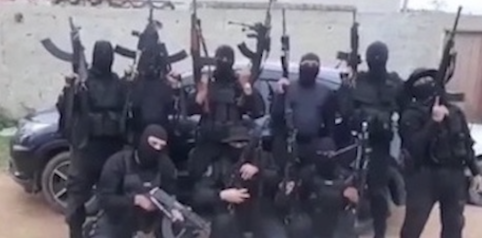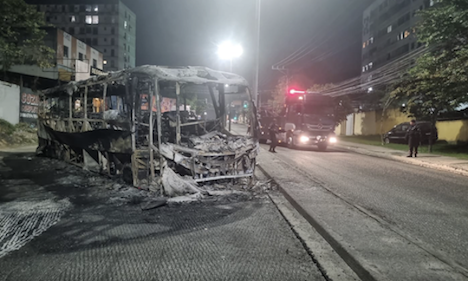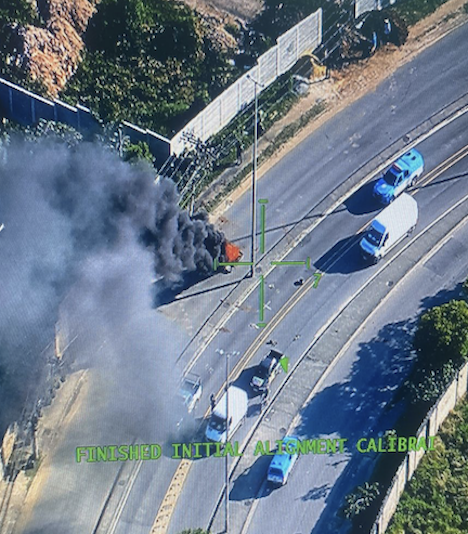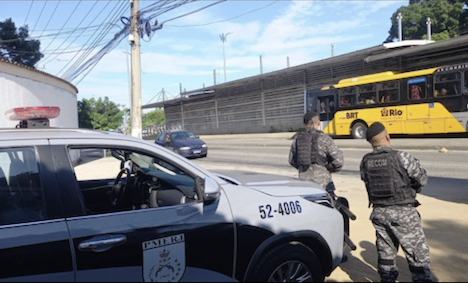Third Generation Gangs Strategic Note No. 54: Milícia Arson Attacks in Retaliation for Police Action in Rio de Janeiro

Third Generation Gangs Strategic Note No. 54: Milícia Arson Attacks in Retaliation for Police Action in Rio de Janeiro
John P. Sullivan and José de Arimatéia da Cruz
A milícia (militia) in the Western Zone of Rio de Janeiro, known as the Bonde de Zinho (Zinho’s Band), conducted arson attacks against ~35 buses, four trucks, and one rapid transit train on Monday, 23 October 2023. The series of attacks were in retaliation for the killing of a senior militia leader Matheus da Silva Rezende, also known as the ‘Senhor de Guerra’ (Lord of War).

Bonde do Zinho. Source: Ministério Público do Estado do Rio de Janeiro (MPRJ)

Burned Bus in Santa Cruz, Rio de Janeiro. Source: @PMERJ, Twitter (X). 23 October 2023, https://x.com/PMERJ/status/1716618734133985733?s=20.
Key Information: : Tom Phillips, “Paramilitary gangs in Brazil torch more than 35 buses in Rio de Janeiro attacks.” The Guardian. 23 October 2023, https://www.theguardian.com/world/2023/oct/24/brazil-rio-de-janeiro-paramilitary-gangs-torch-bus-train-truck-attack-public-transport:
Rio de Janeiro’s state governor, Cláudio Castro, has vowed to strike back against organised crime after paramilitary gangsters launched an unprecedented assault on Rio’s public transport system, torching dozens of vehicles in what the politician called “terrorist acts”.
Criminals reportedly set fire to at least 35 buses and coaches, four lorries and a train on Monday, during what local media described as one of the biggest criminal attacks in Rio’s history.
The attacks were reportedly a retaliation for the killing of a senior paramilitary leader called Matheus da Silva Rezende by police special forces. “He was known as ‘the Lord of War’,” Rio’s right-wing governor claimed at an emergency press conference on Monday evening as security forces and firefighters scrambled to respond to the wave of attacks across western Rio…
… Footage shared on social media showed dozens of passengers throwing themselves off one bus as criminals prepared to set fire to it and thick plumes of black smoke rising into the sky.
The attacks reportedly took place in at least nine different areas – Cosmos, Campo Grande, Inhoaíba, Guaratiba, Madureira, Paciência, Santa Cruz, Sepetiba and Recreio dos Bandeirantes – where about one million people live.
Government officials and media reports attributed the violence to the widely feared milícias (militias) – politically connected mafia-style groups which have seized control of huge swaths of Rio over the past two decades.
Key Information: “Brazil: Rio gangsters torch 35 buses after crime boss killed.” DW (Deutsche Welle). 24 October 2023, https://www.dw.com/en/brazil-rio-gangsters-torch-35-buses-after-crime-boss-killed/a-67192194:
Suspected members of Brazilian criminal groups set fire to at least 35 buses in Rio de Janeiro on Monday, after one of their leaders was killed in a police operation, officials said.
The attacks were concentrated in the west of the city, where so-called militias are fighting for control…
…The military police said it arrested 12 people for suspected “terrorist actions.”…
…The bus burnings occurred shortly after a police operation killed the nephew and right-hand-man of a militia boss known as “Zinho.”…
…Rio’s so-called militias are often made up of current and former police officers.
They were formed as neighborhood protection outfits to combat drug gangs but have since turned into criminal outfits themselves controlling more than half the city’s territory and running multiple different rackets.
Key Information: Leslie Leitãom, Henrique, and Raoni Alves, “”Morte de sobrinho do miliciano Zinho leva terror à Zona Oeste, com 35 ônibus e 1 trem queimados.” G1 (Globo). 23 October 2023, https://g1.globo.com/rj/rio-de-janeiro/noticia/2023/10/23/onibus-do-brt-e-incendiado-apos-sobrinho-de-zinho-ser-baleado-em-troca-de-tiros-com-a-policia.ghtml:
Matheus Rezende, o Faustão, foi baleado na comunidade Três Pontes. Ele era apontado como o número 2 na hierarquia da milícia comandada pelo tio, e o terceiro da família morto pela Polícia Civil. Avenida Brasil chegou a ser fechada por bandidos.
A morte de um miliciano provocou um dia de terror na Zona Oeste do Rio na tarde desta segunda-feira (23). Ao menos 35 ônibus e 1 trem foram queimados a mando de criminosos na região, no dia com mais coletivos incendiados na história da cidade, segundo o Rio Ônibus.
Entre os coletivos queimados, 20 são da operação municipal, 5 do BRT e outros de turismo/fretamento.
Outros veículos e pneus também foram incendiados, fechando diversas vias em bairros como Campo Grande, Santa Cruz, Paciência, Guaratiba, Sepetiba, Cosmos, Recreio, Inhoaíba, Barra, Tanque e Campinho.[1]
Key Information: “’O crime organizado que não ouse desafiar o poder do Estado’, diz Cláudio Castro após morte de miliciano que causou caos no Rio.” G1 (Globo). 23 October 2023, https://g1.globo.com/rj/rio-de-janeiro/noticia/2023/10/23/o-crime-organizado-que-nao-ouse-desafiar-o-poder-do-estado-diz-claudio-castro-apos-morte-de-miliciano-que-causou-caos-no-rio.ghtml:
O governador do Rio de Janeiro, Cláudio Castro, parabenizou a Polícia Civil pela operação contra o crime organizado na Zona Oeste do Rio, nesta segunda-feira (23). Na ação, o miliciano Matheus da Silva Rezende, conhecido como Faustão e sobrinho de Zinho, chefe de maior milícia do Rio, foi baleado. Levado para um hospital, não resistiu e morreu.
“Quero parabenizar os nossos policiais da DGPE, da Core e da Draco, por prenderem hoje, em Santa Cruz, o Faustão ou Teteu – que era o braço direito e sobrinho do miliciano Zinho”, disse Castro em suas redes sociais.
“Além do parentesco com o criminoso, ele atuava como ‘homem de guerra’ do grupo paramilitar, sendo o principal responsável pelas guerras por territórios que aterrorizam moradores no Rio. O crime organizado que não ouse desafiar o poder do Estado!”[2]
Key Information: Fernando David, “Milícia: conheça grupo criminoso que atacou o Rio de Janeiro e explora cariocas.” Jornal da Band (UOL). 24 October 2023, https://www.band.uol.com.br/noticias/jornal-da-band/ultimas/o-que-e-milicia-no-rio-de-janeiro-16642452:
A população foi surpreendida pela ação da milícia que atacou a zona oeste do Rio de Janeiro na segunda-feira (24). 35 ônibus, quatro caminhões e um vagão de trem foram incendiados pelos milicianos, em uma das maiores ações do crime organizado na história da capital fluminense.
Os ataques são o episódio mais recente da história da milícia carioca, que começou pouco mais de duas décadas atrás, quando um grupo de policiais e bombeiros resolveram criar a primeira milícia do estado. Os agentes cobram taxas de moradores e comerciantes, supostamente para ajudar na segurança de comunidades.
O grupo explora serviços de transporte, como vans clandestinas, TV a cabo, venda de água, gás e até imóveis. Em 2008, a CPI das Milícias prendeu as principais lideranças e quem assumiu a região foi uma família com raízes no tráfico.
Com a morte do líder, em 2021, o grupo se fragmentou e o impensável ocorreu: as milícias se aliaram com o tráfico em uma guerra por territórios. E, assim, o modus operandi da milícia mudou.[3]
Key Information: “Caos no Rio de Janeiro: Milícias paramilitares incendeiam 35 autocarros dos transportes públicos” Euronews. 24 October 2023, https://pt.euronews.com/2023/10/24/caos-no-rio-de-janeiro-milicias-paramilitares-incendeiam-35-autocarros-dos-transportes-pub:
Supostos membros de milícias paramilitares incendiaram 35 autocarros, na segunda-feira, no Rio de Janeiro, depois de um dos seus líderes ter sido morto numa operação policial…
A associação de operadores de transportes públicos, Rio Onibus, disse que 35 autocarros foram incendiados, incluindo cinco usados nas linhas especiais de trânsito rápido lançadas para as Olimpíadas do Rio em 2016.
O transporte público foi parcialmente suspenso na zona oeste da cidade.
Grupos de milícias paramilitares controlam mais da metade do território da cidade, instalando um reinado de terror em bairros pobres que abrigam mais de dois milhões de pessoas, de acordo com um estudo de 2020 realizado por um consórcio de universidades, plataformas de vigilância online e uma linha direta anticrime do governo.
Os membros das milícias são frequentemente antigos agentes da polícia.
Eles inicialmente se formaram como grupos de vigilância de bairro para proteger os moradores dos gangues de traficantes da cidade, que é conhecida pelas suas praias pitorescas, mas também pelo crime violento.
As milícias, no entanto, rapidamente evoluíram para grupos do crime organizado, controlando setores que incluem serviços de Internet, televisão por cabo, transportes e construção.[4]
Third Generation Gangs Analysis
Militias (milícias) in Rio de Janeiro have evolved from paramilitary vigilante groups formed by rogue police—former or active police—into organized crime groups in their own right. From a shadow group of enforcers battling gangs and drug trafficking factions (facção) in the favelas, they essentially became another ‘facção’ engaged in narcotics trafficking and other criminal enterprises.[5].
On Monday, 23 October 2023 the militia known as the Bonde do Zinho, after its leader Luis Antônio da Silva Braga, conducted a series of arson attacks in retaliation for the death of Matheus da Silva Rezende, aka ‘Faustão’ or ‘Teteu” at the hands of police special forces. The result was a virtual siege (or micro-siege)[6] in Rio’s Zona Oeste (West Zone), leading to the burning of 35 buses and a train. Schools and businesses were closed. Matheus da Silva Rezende was the nephew of militia members Luís Antônio da Silva Braga, known as Zinho, Wellington da Silva Braga, known as ‘Ecko,’ and Carlos da Silva Braga, known as ‘Carlinhos Três Pontes.’[7]
Faustão is not the first senior militia leader to be killed after a police action. His uncle Wellington da Silva Braga (aka ‘Ecko’) was killed in June 2021. Ecko led a group then known as the “Bonde do Ecko.” That group allegedly had an alliance with the Terceiro Comando Puro (Pure Third Command) against the Comando Vermelho (Red Command).[8] After Ecko’s death, his group set up Incendiary barricades along Avenida Cesário de Melo, a main artery in Rio’s West Zone.[9] The use of terrorist tactics, techniques, and procedures (TTPs) by Brazilian criminal armed groups (CAGs) is not new. The force projection from prisons (i.e., prison-street gang complexes) have been a specialty of the Primeiro Comando da Capital (First Capital Command or PCC) for example.[10] Benjamin Lessing has characterized this type of activity as violent lobbying and violent corruption.[11] Other scholars have viewed this as criminal insurgency or crime wars.[12]
Addressing the violent and corrosive effects of CAGs (gangs and militias) is complex and requires both political and legal interaction, in addition to operational approaches. This research note outlines some of the challenges that emerge from urban criminal violence. Related analyses look at the legal and operational challenges that emerge as milícias and gangs converge.[13]

Polícia Militar do Estado do Rio de Janeiro (PMERJ) Aero and Ground Units Monitor Bus Arson Attack. Source: @PMERJ, Twitter (X). 23 October 2023, https://x.com/PMERJ/status/1716538992726773869?s=20.
Sources
“Brazil: Rio gangsters torch 35 buses after crime boss killed.” DW (Deutsche Welle). 24 October 2023, https://www.dw.com/en/brazil-rio-gangsters-torch-35-buses-after-crime-boss-killed/a-67192194.
“Caos no Rio de Janeiro: Milícias paramilitares incendeiam 35 autocarros dos transportes públicos” Euronews. 24 October 2023, https://pt.euronews.com/2023/10/24/caos-no-rio-de-janeiro-milicias-paramilitares-incendeiam-35-autocarros-dos-transportes-pub.
Fernando David, “Milícia: conheça grupo criminoso que atacou o Rio de Janeiro e explora cariocas.” Jornal da Band (UOL). 24 October 2023, https://www.band.uol.com.br/noticias/jornal-da-band/ultimas/o-que-e-milicia-no-rio-de-janeiro-16642452.
Leslie Leitãom, Henrique, and Raoni Alves, “”Morte de sobrinho do miliciano Zinho leva terror à Zona Oeste, com 35 ônibus e 1 trem queimados.” G1 (Globo). 23 October 2023, https://g1.globo.com/rj/rio-de-janeiro/noticia/2023/10/23/onibus-do-brt-e-incendiado-apos-sobrinho-de-zinho-ser-baleado-em-troca-de-tiros-com-a-policia.ghtml.
“’O crime organizado que não ouse desafiar o poder do Estado’, diz Cláudio Castro após morte de miliciano que causou caos no Rio.” G1 (Globo). 23 October 2023, https://g1.globo.com/rj/rio-de-janeiro/noticia/2023/10/23/o-crime-organizado-que-nao-ouse-desafiar-o-poder-do-estado-diz-claudio-castro-apos-morte-de-miliciano-que-causou-caos-no-rio.ghtml.
Tom Phillips, “Paramilitary gangs in Brazil torch more than 35 buses in Rio de Janeiro attacks.” The Guardian. 23 October 2023, https://www.theguardian.com/world/2023/oct/24/brazil-rio-de-janeiro-paramilitary-gangs-torch-bus-train-truck-attack-public-transport.

Polícia Militar Monitor Bus Rapid Transit (BRT) Station in Aftermath of Milícia Attacks. Source: Twitter (X). 24 October 2023, https://x.com/PMERJ/status/1716781582529561058?s=20.
Endnotes
[1] In English, the title reads: The text reads: “Matheus Rezende, known as Faustão, was shot in the Três Pontes community. He was identified as number 2 in the hierarchy of the militia commanded by his uncle, and the third member of the family killed by the Civil Police. Avenida Brasil was closed by bandits. […] The death of a militia member caused a day of terror in Rio’s West Zone on Monday afternoon (23). At least 35 buses and one train were burned at the behest of criminals in the region, on the day with the most buses set on fire in the city’s history, according to Rio Ônibus. […] Among the buses burned, 20 were municipal buses, 5 were BRT {bus rapid transit] buses and others were tourist/charter buses. […] Other vehicles and tires were also set on fire, closing several roads in neighborhoods such as Campo Grande, Santa Cruz, Paciência, Guaratiba, Sepetiba, Cosmos, Recreio, Inhoaíba, Barra, Tanque and Campinho.”
[2] In English, the title reads: “’Organized crime shouldn’t dare challenge the power of the state,’ says Cláudio Castro after the death of the militia member who caused chaos in Rio.” The text reads: “The governor of Rio de Janeiro, Cláudio Castro, congratulated the Civil Police for the operation against organized crime in the West Zone of Rio on Monday (23). During the operation, militia member Matheus da Silva Rezende, known as Faustão and nephew of Zinho, the head of Rio’s largest militia, was shot. He was taken to hospital but didn’t survive and died. […] ‘I want to congratulate our DGPE [Departamento Geral de Polícia Especializada or specialized police], CORE [Coordenadoria de Recursos Especiais or Civil police tactical unit] and DRACO [Delegação para Repressão de Ações Criminosas e Investigações Especiais or Delagation for Repression of Criminal Actions and Special Investigations (organized crime investigations)] police officers for arresting Faustão or Teteu – who was the right-hand man and nephew of the militia boss Zinho – today in Santa Cruz,’ Castro said on his social networks. […] ‘As well as being related to the criminal, he acted as the paramilitary group’s ‘man of war,’ and was mainly responsible for the turf wars that terrorize residents in Rio. Let organized crime not dare challenge the power of the state!’”
[3] In English, the title reads: “Militia: meet the criminal group that attacked Rio de Janeiro and exploits cariocas.” The text reads: “The population was surprised by the militia action that attacked the western zone of Rio de Janeiro on Monday (24). 35 buses, four trucks and a train car were set on fire by the militiamen, in one of the largest organized crime actions in the history of the Rio de Janeiro capital. The attacks are the most recent episode in the history of Rio’s militia, which began just over two decades ago, when a group of police officers and firefighters decided to create the state’s first militia. The agents collect fees from residents and shopkeepers, supposedly to help with community security. […] The group operates transportation services, such as clandestine vans, cable TV, the sale of water, gas and even real estate. In 2008, the CPI on Militias [Comissão Parlamentar de Inquérito das Milícias or Congressional Inquiry committee on militias] arrested the main leaders and a family with roots in drug trafficking took over the region. With the death of the leader in 2021, the group fragmented and the unthinkable happened: the militias allied themselves with drug traffickers in a war for territory. And so the militia’s modus operandi changed.
[4] In English, the title reads: “Chaos in Rio de Janeiro: Paramilitary militias set fire to 35 public transport buses.” The text reads: “Alleged members of paramilitary militias set fire to 35 buses in Rio de Janeiro on Monday after one of their leaders was killed in a police operation. […] The association of public transport operators, Rio Onibus, said that 35 buses were set on fire. Public transportation was partially suspended in the western part of the city. […] Paramilitary militia groups control more than half of the city’s territory, installing a reign of terror in poor neighborhoods that are home to more than two million people, according to a 2020 study carried out by a consortium of universities, online surveillance platforms and a government anti-crime hotline. [Details on that study are documented at John P. Sullivan, José de Arimatéia da Cruz, and Robert J. Bunker, “Third Generation Gangs Strategic Note No. 32: Militias (Milícias) Surpass Gangs (Gangues) in Territorial Control in Rio de Janeiro.” Small Wars Journal. 26 October 2020, https://smallwarsjournal.com/index.php/jrnl/art/third-generation-gangs-strategic-note-no-32-militias-milicias-surpass-gangs-gangues.] […] Militia members are often former police officers. They initially formed as neighborhood watch groups to protect residents from drug gangs in the city, which is known for its picturesque beaches but also for violent crime. The militias, however, quickly evolved into organized crime groups, controlling sectors including internet services, cable television, transport and construction.”
[5] See Paulina Villegas, “Police militias fought Brazil’s gangs. Now they extort, traffic and kill, too.” Washington Post. 26 September 2023, https://www.washingtonpost.com/world/2023/09/26/brazil-police-militias/.
[6] Virtual or micro siege is a tactic where armed groups (terrorists or gangsters) use swarming tactics to create a metaphorical siege denying community activities and amplifying fear. See John P. Sullivan, “Policing Urban Conflict: Urban Siege, Terrorism and Insecurity.” Stratfor. 19 April 2018, https://www.academia.edu/36721271/Policing_Urban_Conflict_Urban_Siege_Terrorism_and_Insecurity for an overview. Recent examples of this tactical approach were seen in the battles between the Sinaloa Cartel and Mexican security forces in Culiacàn, in 2019 and 2023. Similar tactics, techniques, and procedures (TTPs) are also used by criminal armed groups in Brazil’s Novo Cangaço. See Daniel Weisz Argomedo, Nathan P. Jones, and John P. Sullivan, “Virtual Urban Siege: Modern Urban Siege and Swarming in Culiacán 2019 & 2023.” Journal of Strategic Security. Vol 16,no. 3, 2023, pp. 30–52, https://digitalcommons.usf.edu/jss/vol16/iss3/4.
[7] See “Ecko, Carlinhos Três Pontes e Faustão viveram e morreram na mesma comunidade, berço da maior milícia do Rio.” O Globo. 25 October 2023, https://oglobo.globo.com/rio/noticia/2023/10/25/ecko-carlinhos-tres-pontes-e-faustao-viveram-e-morreram-na-mesma-comunidade-berco-da-maior-milicia-do-rio.ghtml. Zinho is also linked to the Milíca Liga Justiça (Justice League) an earlier name of the militia, See “Zinho, Luis Antonio da Silva Braga.” Portal Procurados, https://www.procurados.org.br/procurado/3661.
[8] Chris Dalby, “Killing of Brazil’s Top Militia Leader Raises More Questions Than it Answers.” InSight Crime. 16 June 2021, https://insightcrime.org/news/killing-of-brazils-top-militia-leader-raises-more-questions-than-it-answers/.
[9] “Após morte de Ecko, Zona Oeste do Rio tem queima de pneus e barricadas.” G1 (Globo). 12 June 2021, https://g1.globo.com/rj/rio-de-janeiro/noticia/2021/06/12/protestos-zona-oeste.ghtml.
[10] See Guilherme Damasceno Fonseca, “The Use of Terrorist Tools by Criminal Organizations: The Case of the Brazilian Primeiro Comando Da Capital (PCC).” Perspectives on Terrorism. Vol. 14, no. 4, 2020, pp. 64–82. JSTOR, https://www.jstor.org/stable/26927664.
[11] Benjamin Lessing, “Logics of Violence in Criminal War.” Journal of Conflict Resolution. Vol. 59, no. 8, https://journals.sagepub.com/doi/10.1177/0022002715587100.
[12] See for example, Robert Muggah and John P. Sullivan, “The Coming Crime Wars.” Foreign Policy. 21 September 2018, https://foreignpolicy.com/2018/09/21/the-coming-crime-wars/; Jan Daniel, “Criminal Governance and Insurgency: The Rio de Janeiro Experience. Central European Journal of International and Security Studies. Vol. 9, no. 4, 2015, pp. 86–106, https://cejiss.org/images/issue_articles/2015-volume-9-issue-4/article-03.pdf; and Christian Vianna de Azevedo, “Criminal Insurgency in Brazil: The Case of Rio de Janeiro: Context, Confrontation Issues and Implications for Brazilian Public Security.” Small Wars Journal. 22 January 2018, https://smallwarsjournal.com/jrnl/art/criminal-insurgency-brazil.
[13] See for example the International Review of the Red Cross issue “Organized Crime” on the convergence of complex legal and operational issues in both armed conflict and other situations of violence. Specifically, see Najla Nassif Palma, “Is Rio de Janeiro preparing for war? Combating organized crime versus non-international armed conflict.” International Review of the Red Cross. IRRC No. 923, June 2023, https://international-review.icrc.org/articles/is-rio-de-janeiro-preparing-for-war-923 and John P. Sullivan, “Crime wars: Operational perspectives on criminal armed groups in Mexico and Brazil.” International Review of the Red Cross. IRRC No. 923, June 2023, https://international-review.icrc.org/articles/crime-wars-operational-perspectives-923.
For Additional Reading
John P. Sullivan, “Crime wars: Operational perspectives on criminal armed groups in Mexico and Brazil.” International Review of the Red Cross (IRRC), No. 923, June 2023.
John P. Sullivan and Robert J. Bunker, Editors, Competition in Order and Progress: Criminal Insurgencies and Governance in Brazil. Bloomington: Xlibris, 2022.
John P. Sullivan, José de Arimatéia da Cruz, and Robert J. Bunker, “Third Generation Gangs Strategic Note No. 51: Milícias (Militias) Continue to Surpass Gangues (Gangs) in Dominating Criminal Territory in Rio de Janeiro.” Small Wars Journal. 27 September 2022.
John P. Sullivan and Robert J. Bunker, “Criminal Armed Groups Compete with the State and Each Other.” Word on the Street (Urban Violence Research Network), 14 July 2022.
John P. Sullivan, José de Arimatéia da Cruz, and Robert J. Bunker, “Third Generation Gangs Strategic Note No. 32: Militias (Milícias) Surpass Gangs (Gangues) in Territorial Control in Rio de Janeiro.” Small Wars Journal. 26 October 2020.
Christian Vianna de Azevedo, “Criminal Insurgency in Brazil: The Case of Rio de Janeiro: Context, Confrontation Issues and Implications for Brazilian Public Security.” Small Wars Journal. 22 January 2018.







